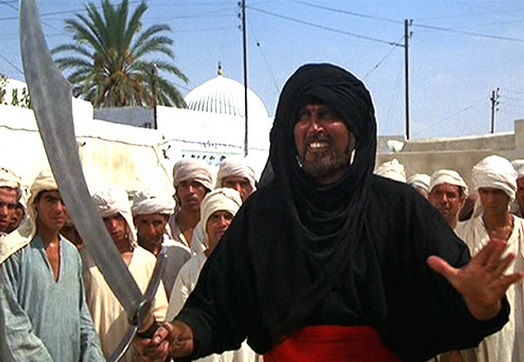  |
 |
 |
 |
|
MahdiWatch.org
|
 |
|
Home | About Me | Links to My Articles | Info on My Books | Contact Me
|
 |
|
Welcome to MahdiWatch.org! NEWSFLASH! COMMENTS LINK
BELOW EACH POST IS ENABLED! FEEL FREE TO BURY ME, PRAISE ME--OR JUST ISSUE A PERSONAL FATWA!
al-Mahdi is "the rightly-guided one" who, according to Islamic Hadiths (traditions),
will come before the end of time to make the entire world Muslim. Over the last 1400 years numerous claimants to the
mantle of the Mahdi have arisen in both Shi`i and Sunni circles. Modern belief in the coming of the Mahdi has
manifested most famously in the 1979 al-`Utaybi uprising of Sa`udi Arabia, and more recently in the ongoing
Mahdist movements (some violent) in Iraq, as well as in the frequently-expressed public prayers of former Iranian
President Ahmadinezhad bidding the Mahdi to return and, in the larger Sunni Islamic world, by claims that Usamah bin Ladin
might be the (occulted) Mahdi. Now in 2014 Mahdism is active in Syria, as the jihadist opposition group Jabhat al-Nusra
claims to be fighting to prepare the way for his coming; and in the new "Islamic State/caliphate" spanning
Syrian and Iraqi territory, as its leadership promotes the upcoming apocalyptic battle with the West at Dabiq, Syria. This site will track such Mahdi-related movements, aspirations, propaganda and beliefs in both Sunni and Shi`i
milieus, as well as other Muslim eschatological yearnings.
For a primer
on Mahdism, see my 2005 article, "What's Worse than Violent Jihadists?," at the History News Network: http://hnn.us/articles/13146.html; for more in-depth info, see the links here to my other writings, including my book on Mahdism.
|
|
|
|
Sunday, July 20, 2014
Is Insisting Every Adulterer Must Get Stoned REALLY "Extremist" in Islam?
A few days ago the Iraqi-Syrian caliphate meted out the punishment of stoning for a woman accused of adultery. Predictably, many media outlets decried the "extremists" who carried out such a heinous sentence.
But is stoning in such cases really "extremist" according to Islamic doctrines and public opinion?
No. There are at least five authoritative hadiths--sayings going back to Islam's founder, Muhammad--which mandate such a method of execution for adulterers.
And according to Pew data from 2012, in many Muslim countries of the Mideast, Africa and South Asia large majorities want shari`ah to
be implemented, and most of them in turn favor stoning for adulterers/adulteresses:
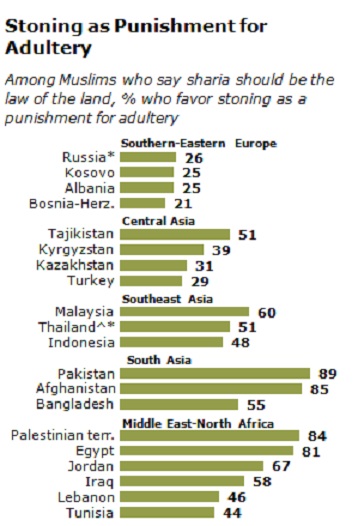
The "prophet" of Islam sanctioned stoning for adultery; the practice was legal praxis
in many Islamic societies across the 14 centuries from his time to today; and clear majorities of Muslims in many countries
approve of it. How, then, is it "extremist?" Brutal, harsh, vindictive, bloody, barbaric, outmoded--but
according to Islamic history and modern sentiments, stoning is not "extremist" at all.
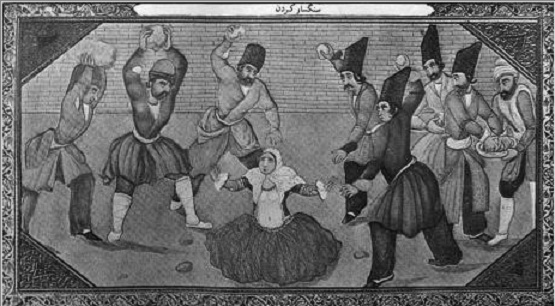
Public stoning in Qajar Iran (19th century).
Apologists can sputter all they want, but the fact is that many of the world's Muslims would not feel that what ISIS
just did is beyond the pale; on the contrary, like the Taliban or Boko Haram, ISIS at least has the courage of its Qur'anic
and Muhammadan convictions--appalling as that may be.
For those (liberals and Muslims) who stupidly maintain that there
is no difference between Islam and Christianity, between Muslims and Christians--I leave you with this clip from "Jesus of Nazareth."

Gospel of St. John, 8:1-11. Quite a contrast from Muhammad's example.
Monday, July 14, 2014
New Islamic State Magazine "Dabiq": Western Forces On the Eve of Destruction
Since the Islamic State of Iraq and al-Sham [Greater Syria] declared the resurrection of the caliphate a few weeks ago, analysts and journalists have focused on the ramifications of that putative political office for the Islamic world. However, at the start of Ramadan the new “Islamic
State” and its caliph attempted to move the propaganda needle from the merely realpolitickally ridiculous to
the apocalyptically awe-inspiring—by invoking Muslim eschatological traditions.
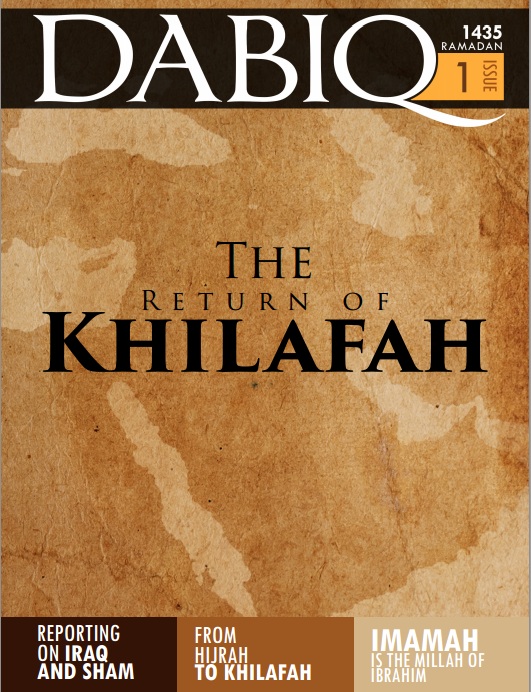
The venue for this is an online English magazine entitled Dabiq: The Return of Khilafah, the 50 pages of which skillfully blend Qur’anic citations (10 in
total), hadiths (12 of these), Salafi-jihadist exegesis and imagery to legitimize the new caliphate, motivate the faithful,
and reach out to (primarily) Western Muslims. The main proof text of this entire document
is a lengthy hadith (saying attributed to Islam’s founder, Muhammad) about a major Last Hour battle. Since
IS’s magazine quotes the entire hadith twice, and refers to it several other times, the tradition is worth quoting in
full:
Abu Huraira reported Allah's Messenger (may peace be upon him) as saying:
The Last Hour would not come until the Romans would land at al-A'maq or in Dabiq. An army consisting of the best (soldiers)
of the people of the earth at that time will come from Medina (to counteract them). When they will arrange themselves in ranks,
the Romans would say: Do not stand between us and those (Muslims) who took prisoners from amongst us. Let us fight with them;
and the Muslims would say: Nay, by Allah, we would never get aside from you and from our brethren that you may fight them.
They will then fight and a third (part) of the army would run away, whom Allah will never forgive. A third (part of the army).
which would be constituted of excellent martyrs in Allah's eye, would be killed and the third who would never be put to trial
would win and they would be conquerors of Constantinople. And as they would be busy in distributing the spoils of war (amongst
themselves) after hanging their swords by the olive trees, the Satan would cry: The Dajjal has taken your place among your
family. They would then come out, but it would be of no avail. And when they would come to Syria, he would come out while
they would be still preparing themselves for battle drawing up the ranks. Certainly, the time of prayer shall come and then
Jesus (peace be upon him) son of Mary would descend and would lead them in prayer. When the enemy of Allah would see him,
it would (disappear) just as the salt dissolves itself in water and if he (Jesus) were not to confront them at all, even then
it would dissolve completely, but Allah would kill them by his hand and he would show them their blood on his lance (the lance
of Jesus Christ) [Sahih Muslim,
“Kitab al-Fitan wa Ashrat al-Sa`ah,” #6924].
Dabiq
is just north of Aleppo, near the Turkish border,
and al-`Amaq/al-`Amq is in the same vicinity.
(Both are near Hatay, of Indiana Jones
fame.) A type of the
eschatological battle described in
this collection of Muslim b. al-Hajjaj (d. 875 AD) was fought at or near that location in 1516 between the Ottoman Turks and
the Egyptian Mamluks. The heirs of the Eastern Romans won that battle decisively, thanks to their effective
use of artillery—thus leading to the four centuries of Ottoman dominance over the Arab Middle East.
To sum up this hadith: the Romans land an expeditionary force in northwest Syria; after heavy losses the Muslims defeat
them and conquer “Constantinople;” the Dajjal—the “Deceiver,” or Muslim Antichrist—appears
and then the returned Jesus dispatches him via melting or lance.
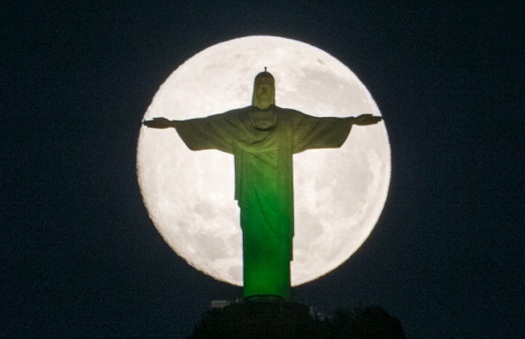
The last thing the Dajjal will ever see....
The writers credit the late Abu Mus`ab al-Zarqawi, decapitator extraordinaire of the IS[IS] predecessor organization the Islamic State in
Iraq, with first linking the jihad there to the End Time battle at Dabiq. Also, Dabiq has several
pages extolling al-Zarqawi’s virtues and strategic vision for rec-creating the caliphate via these stages: 1) hijrah
2) jama`ah 3) destabilizing the taghut 4) tamkin 5) khilafah. The
original hijrah was the “flight” of Muhammad and the small Muslim community from Mecca to Yathrib/Medina
in 622 AD. Ever since, this exploit has served as an example for groups of Muslims who deem their society
and/or rulers insufficiently pious and who thus repeat the paradigm of flee, consolidate power and return to conquer.
Jama`ah is “community,” the expected group solidarity that hardens during hijrah. Such
a community then must act to undermine the tyrannical regime(s), the taghut (literally “despots” or “gorillas”).
As the oppressive rulers are rendered illegitimate via jihad and tuwwahhush (literally
“savagery” or “brutality”), controlling less and less territory, the true Muslims will be able to
consolidate power (tamkin), ultimately leading to the caliphate—as IS[IS] has now proclaimed. This
rising new Muslim power “will trample the idol of nationalism, destroy the idol of democracy” and trigger the
“demolition of Sykes-Picot” (the World War I British-French agreement which laid out plans for those two nations to rule
over the Arab sections of the post-war Ottoman Empire). This
five-step program for attaining power can be repeated elsewhere—notably Yemen, Mali, Somalia, Sinai Peninsula, Waziristan,
Libya, Chechnya, and Nigeria, as well as in certain areas of of Tunisia, Algeria, Indonesia, and the Philippines.
Dabiq also takes a number of pages
to lay out an Islamic theological basis for the political power being claimed by “Caliph” Ibrahim.
The central argument is that “the concept of Imamah [political power] is from the millah [religious confession]
of Ibrahim.” Ibrahim, the Qur’anic version of the Biblical Abraham, was a “leader for
mankind” because he followed Allah. If al-Baghdadi’s true name is Ibrahim Awwad Ibrahim Ali
al-Badri, this is likely a case of IS[IS] attempting to theologically leverage the “Caliph’s” birth and
regnal name. Those who oppose him are “weak-hearted” who “makes fools of themselves”
and thus “renegades” whose necks it it legitimate to strike—to behead, that is. The Islamic State has “gained control over territory larger than many states…lands formerly under the
control of the historical Umawi khulafa’ [caliphs] of Sham and the `Abbasi khulafa’ of Iraq.”
(The Umayyad ruled the nascent Islamic empire from Damascus, 661-750 AD; they were supplaned by the Abbasids, who ruled from
Baghdad, 750-1258 AD.) Furthermore, “this new condition opens the path for the complete unification of all Muslim peoples
and lands under the single authority of the Khalifah. May Allah protect this Khilafah state and continue guiding it until
its legions fight the crusader armies who will gather near Dabiq.”
There are several other topical sections of Dabiq: one about the
“liberated” areas, with pictures of allegedly welcoming throngs; another deploying gruesome pictures of dead and
maimed or severely injured children, alleged targets of the Iraqi and Syrian government forces; yet another boasting of the
thousands of repentant Rafidis (“refusers”), murtaddin (“apostates) or Safawis (the
Safavid Empire was the one that ruled Iran from 1501-1722 and fought, tooth-and-nail, against the Sunni Ottomans) being captured
and brought to the true Islamic faith. (There are also plenty of photos of dead Shi`is, as well as some
about to be executed by IS[IS].)
This
magazine even hijacks Tolkien: the massed Rohirrirm cavalry about to ride down upon the legions of Orcs beseiging Minas Tirith
(from The Return of the King) are shown on the bottom of a page exalting the coming unification of all Muslims under
the caliphate. One can only surmise that such an image is aimed at portraying the IS[IS] as outnumbered
battalions fighting heroically against seemingly insurmoutable odds—and, of course, winning, much as do the Muslims
at the battle of Dabiq, vanquishing the Romans/crusaders with only the remaining 1/3 of their forces. But, again, on
the last page, Dabiq comes back around to eschatology—reprinting in toto the aforementioned hadith
from Muslim b. al-Hajjaj.

"A sword day! A red day! And the Sun rises--in the West!?"
Observations:
1) The first English-language publication by the first caliphal state to be proclaimed since the demise of the Ottoman
one 90 years ago is focused on apocalyptic themes—specifically an End Times’ Armageddonesque battle and the entry
into history two of the three major Muslim eschatological figures: the Dajjal and Jesus. “Caliph
Ibrahim” and his staff would not have sanctioned such an endeavor without good reason. The
Muslims must have one man to lead them all against the evil Westerners in the great battle soon to come in Syria. Resistance
to him is futile—and treasonous. Join the inevitable winning side.
2) The IS leadership no doubt knows anecdotally what Pew data told us empirically in 2012: that eschatological beliefs in the Islamic world are not “fringe” or “extreme”
but, in point of fact, are quite mainstream, even in Sunni Islam: 42% of Muslims expect the Mahdi—Islam’s primary End
Time actor—to come in their lifetimes, while 35% look for Jesus’ imminent return. In
Iraq, the figures are 72% and 64%, respectively. Syria was not included in the polling,
but considering the raging bloody civil war there, it’s quite likely that similar apocalyptic expectations exist—and
the new caliphate aims to exploit such in Iraq, Syria and beyond. And while Dabiq appears aimed
at a Western (Muslim?) audience, and at Muslims living in diaspora here, it’s also quite accessible to anyone in the
Middle East proper with a computer, Internet access and rudimentary English skills.
3) Dabiq adduces, and advertises, a hadith which speaks of
the Antichrist and Jesus—but not the Mahdi. Traditional exegesis of this (and
similar) hadith(s) holds that the leader of Muslims at the Battle of Dabiq/al-`Amaq will be the Mahdi
himself. Does this mean that the IS leadership (and rank-and-file) considers
Ibrahim to be not just caliph but Mahdi—but is simply loathe to say so in its first publication? Or
is the head of the “new caliphate” a ruler who prepares the way, and the realm, for the actual eschatological
leader?
4) Either way, the clearly-stated doctrine of tawwahhush gives this new, self-styled caliph a license not
just to kill but to brutalize and sow panic as a means of undermining any target regime. This is working
in Syria and Iraq. Is Jordan or Saudi Arabia next? As my friend Dr. Ted Karasik wrote earlier today, tawwahhush might very well mean biological, chemical or nuclear/radiological
warfare. A caliph might decide to deploy such weapons, either on his own recognizance or as a means of
hotwiring the apocalypse/arrival of the Mahdi. And if Ibrahim/al-Baghdadi thinks himself the Mahdi, then
any and all weapons are acceptable to wage war fi sabil Allah: “in the path of Allah.”
5) As I noted in last week’s blogpost (Saturday, July 5, 2014), a number of Sunni
factions are speaking out against the caliphal claims of the IS: Lebanese shaykhs; professors at al-Azhar
in Cairo; Yusuf al-Qaradawi; even pro-caliphate Hizb al-Tahrir. To this list we can now add current Turkish
politician and former head of the Organization of Islamic Cooperation, Ekmeleddin Ihsanoğlu, as well as a coterie of British imams. These condemnations are good, but more, and more official ones, are needed.
Where are the fatwas from the world’s most influential Muslim, Dr. Ahmad Muhammad al-Tayyib, rector of al-Azhar;
or Dr. Ali Guma, former Grand Mufti of Egypt? Kinetic—military—operations against the IS are
of course necessary, and are currently being carried out by the likes of Ansar al-Islam and, most doggedly, Jaysh Rijal al-Tariqah al-Naqshbandiyah (“Army of the Men of the Naqshandi [Sufi] Order”). Although composed
primarily of former Saddam Hussein government and military members, many of his Ba`ath (Arab Socialist) party, it seems that
many in JRTN are also practicing Sufis—Islamic mystics. The Naqshbandi order is one of the oldest
and perhaps the largest of the dozens (at least) of extant Sufi networks, and it has historically been the one most prone
to waging violent jihad; for example, Naqshbandis fought many insurrections against the Ottoman Empire. If
the newly-minted caliph indeed has Mahdist aspirations, there is perhaps no group better suited to beat it out of him and
his followers. Still, it’s possible for opponents of the IS to win
the shooting war but lose the ideological one.
The Caliphate has returned, whether we like it or not. The IS, as evidenced by Dabiq,
clearly thinks the eschatological clock is ticking. Let’s hope it won’t be necessary to raise
the Mahdist alarm.
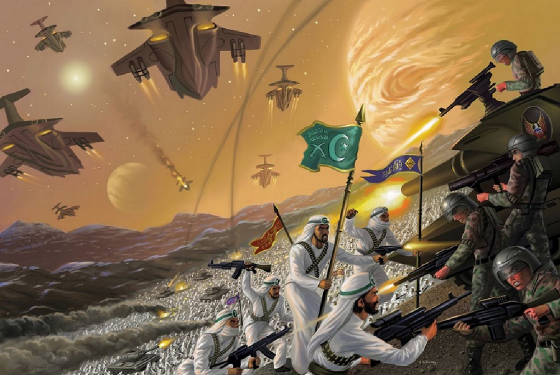
Dabiq might go something like this. (Credit to AlanGutierrezArt. I hope the print of this I ordered arrives soon!)
12:31 am edt
Saturday, July 5, 2014
Little Sympathy for the Devil: Sunni Muslims Critique ISIS' Caliphate
C.S. Lewis said that two equally unfortunate errors can be made regarding the devil. One is to deny his existence; the other is to be overly fascinated with
him and overestimate his power. Such is also good advice regarding the new caliphate proclaimed by the
“Islamic State [of Iraq and al-Sham]”: this challenge to the geopolitical order cannot simply
be laughed off as a bad Muslim joke; but neither should the pretensions of “Caliph Ibrahim” (Abu Bakr al-Baghdadi,
né Ibrahim Ali al-Badri) be treated as if the Ottoman caliphate was once again lording it over the Middle East
and threatening to march on Vienna or Rome.
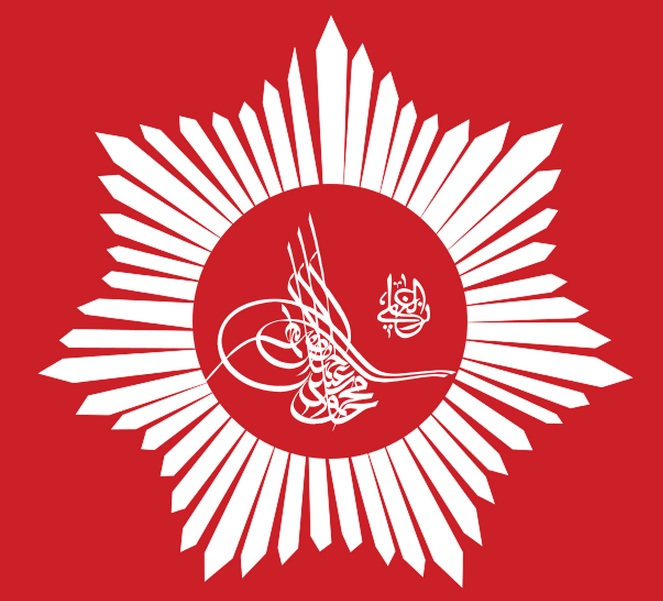
An Ottoman caliphal standard--from back in the day, when few argued about the caliph's
legitimacy.
As I observed in several immediately
previous posts, the major strength of the “Islamic State”—and the one characteristic which largely differentiates
it from al-Qa`idah—is that it holds substantial contiguous territory, and in the Islamic heartland (not on failing state
peripheries). This very strength, however, also represents a grave weakness, for it makes the IS
vulnerable to air strikes and other modes of conventional warfare.However,
kinetic operations, while almost certainly necessary, will prove insufficient to destroy this new Islamic polity.
Some measure of political and, yes, religious de-legitimization must be meted out—and this can only be done by
Muslim authorities, not by Western and Christian leaders.
And that might be happening. As
of this writing, three Islamic entities and one prominent individual have already rejected “Caliph Ibrahim:”
1) Prominent and influential Sunni Salafi (Islamic literalist/fundamentalis) shaykhs in Lebanon have outright rejected “Caliph Ibrahim.” These Salafis
do not question the caliphate per se, of course; rather their scorn derives from the fact that “these [ISIS]
people are not the ones who deserve to declare something as great as the Islamic caliphate” and that ISISites have “rushed”
doing so, sans the “foundations” of a caliphate, which do not yet exist.
2) Three branches of the global Hizb al-Tahrir (“Party of Liberation”) movement—which for 50 years has been working
to resurrect the caliphate—have scorned the “Islamic State.” The Lebanese spokesman said
that the caliphate would not be resurrected via “blood, charges of apostasy and explosions.” HT's
Jordanian mouthpiece averred that since ISIS lacked a legitimate predecessor sultan, or “political leader,” it
could not leapfrog to the higher office of caliphate. And the HT representative in the UK critiqued the
new “caliphate” on two fronts: not having firm control of, and being recognized as politically legitimate in,
the Syria-Iraq region; and for not having drawn loyalty (ba`yah) from important Islamic sectors and leaders.
3) Professors and experts in Islamic history
and law at al-Azhar Mosque/University in Cairo have belittled the new “caliphate” for various and sundry reasons.
As might be expected, many of the faculty at this august Sunni institution derided ISIS as a mere terrorist organization,
unworthy of the caliphate—although at least one expressed conspiracy theory-level drivel that ISIS was a creation of
“Western intelligence.” Yet another, a professor of shari`ah, laughably stated that “there
is no political caliphate associated with Islam”—which would have been news to the Abbasids, Fatimids and Ottomans,
among others.
However, let it be noted that “so far, al-Azhar has not issued any official stance
regarding ISIS.” Until such time as the Grand Imam, Shaykh Ahmad Muhammad al-Tayyib—currently
ranked the #1 most influential Muslim on the planet—decides to do so, the caliphal “Islamic State” under its “Caliph
Ibrahim” will remain at least quasi-legitimate in the eyes of too many Muslims. Had the Obama Administration
not poisoned the well in Egypt, by its myopic and misguided support for the Muslim Brotherhood, it might have sufficient pull
there to help persuade the government in Cairo of the need for al-Azhar to get into the IO/IW/Strategic PSYOP fight against
ISIS. But since POTUS and his State Department took sides against al-Azhar (which was, and is, anti-MB),
such support from al-Sisi is probably out of reach.
4) Influential free-lance Sunni cleric Yusuf al-Qaradawi has condemned the IS caliphate as contravening shari`ah—although he has not spelled out exactly this is the case.
The other major Islamic entity—albeit
more political than religious—that might weigh in against the “Islamic State” is the
multi-state, transnational Organization of Islamic Cooperation. Yet, to date, the OIC has been silent on the issue. One
wonders where President Obama’s much-ballyhooed representative to the OIC, Rashad Husain, is, and why POTUS hasn’t dispatched him to rally international
Muslim opinion against “Caliph Ibrahim.”Perhaps an administration
that refuses to admit the historical reality of jihad also has its head buried deep in the sand regarding the Islamic validity, and thus menace,
of a jihadist caliphate in the heart of the Middle East.
Note: none of these
four Islamic critiques of “Caliph Ibrahim” really addresses the seven prerequisites for the caliphate spelled out by Ibn Khaldun six centuries ago. Most aformentioned attacks
are mere ad hominem ones, which will frankly fail to undermine the “Islamic State.” Predictions
of the new caliphate’s inevitable and imminent demise might well be overstated in the absence of such Muslim ideological
undermining of the polity's plausible bases.
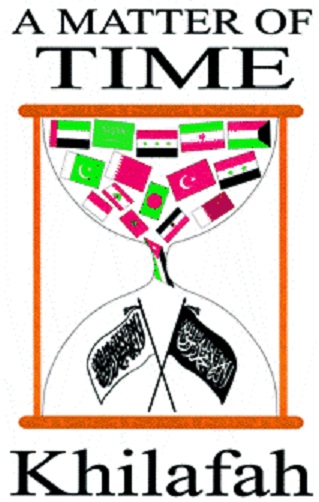
2:35 pm edt
Wednesday, July 2, 2014
Strict Statutes and Most-Biting Laws: Taking the Measure of the Islamic State
With the Islamic State of Iraq and al-Sham annexing large sections of Iraq and Syria, and the
subsequent proclamation of a new caliphate under Ibrahim al-Badri, or “Abu Bakr al-Baghdadi”—ruling as “Caliph
Ibrahim”—the current clash of civilizations (between Islam and every other one, particularly the Christian West)
enters a new and potentially more ominous phase. But while a terrorist-created caliphate is a net negative
for the world (Muslims included), the caliphate per se may yet result in some positives for the modern world—as
per the title of my not-yet-completed book, The Caliphate: Threat or Opportunity?
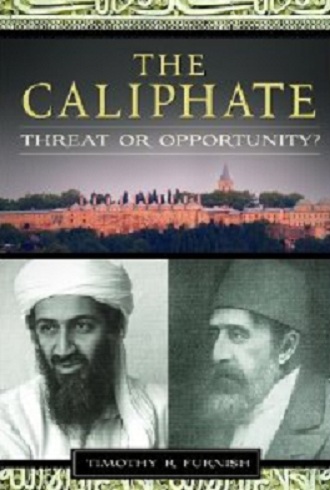
My once and future
book....
Some history of this primary Islamic political
institution is in order, considering how many misapprehensions exist on the topic. Khalifah
means “successor” to Muhammad as leader of the Muslim community/state, in both a political and religious
sense—as pointed out by Patricia Crone and Martin Hinds, in God’s Caliph: Religious Authority in the First
Centuries of Islam (Cambridge, 1984). In fact, according to Crone and Hinds, the office of the caliph
even had eschatological overtones insofar as the occupant thereof was “rightly-guided” by Allah in the same way
(though perhaps not as intensely) as the End Times Mahdi would be. Shi`is of various stripes eventually
eschewed the caliphate as a usurping Sunni office, opting instead for the Imamate dependent upon Muhammad’s male descendants
via Ali, Hasan or Husayn, and their offspring—whether the legitimate line ran through the 5th Imam (Zaydis), the 7th
(Isma’ilis) or the 12th (Twelvers). Only one Shi`i group—the Ismai’li Sevener Fatimids,
who ruled Egypt in the medieval period—really used the term “caliph” for its leaders, perhaps to curry legitimacy
with the bulk of Egypt’s population, which always remained staunchly Sunni. 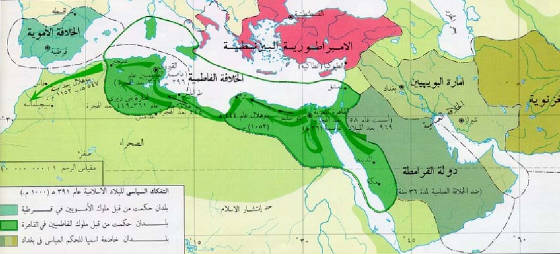 The Fatimid Caliphate-Imamate, in dark green, 970-1171 AD. The Fatimid Caliphate-Imamate, in dark green, 970-1171 AD.
The other major caliphates in history were all unambiguously Sunni;
those of: the Rashidun (“rightly-guided”), the first four men to succeed Muhammad; the Umayyads of Damascus
(661-750 AD); the Abbasids of Baghdad—Islam’s “Golden Age”—from 750-1258
AD; and the Ottomans, who ruled for some six centuries until right after World War I. One
other caliphate was something of an outlier: that of the North African al-Muwahhidun, or “Almohads,” which was
founded as an overtly Mahdist state by Ibn Tumart in the 12th century AD but which, after his death, transformed into a (mere)
caliphate.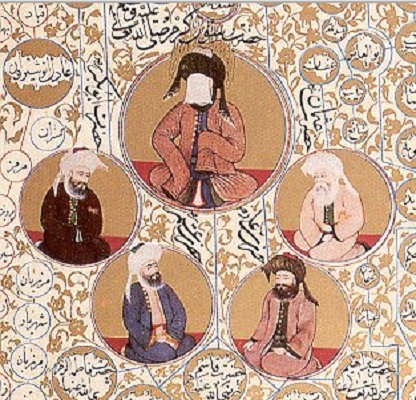 Muhammad (with lens flare) & the four "Rashidun" caliphs: Abu
Bakr, Umar, Uthman & Ali. No idea which is which. Muhammad (with lens flare) & the four "Rashidun" caliphs: Abu
Bakr, Umar, Uthman & Ali. No idea which is which.
Other
lesser, regional caliphal states have been proclaimed in the past, such as Usman don Fodio’s Sokoto Caliphate of what
is now northern Nigeria, and several short-lived ones in the Iberian Peninsula. But over the last several
centuries, the most powerful and important caliphate, by far, was that of the Ottomans, adduced by Abülhamid II (Abd al-Hamid II) in the late 19th/early
20th century as a rallying point for Pan-Islamic unity. With the Ottoman defeat in World War I and the
onset of the Turkish Republic, the new secular rulers of Turkey first dissolved the political power of the House of Osman—the
sultanate—but allowed it to retain the caliphate as a spiritual authority for Muslims. But in 1924
even this was eradicated, and the last caliph—Abdülmecid (Abd al-Majid)—was exiled to Paris. 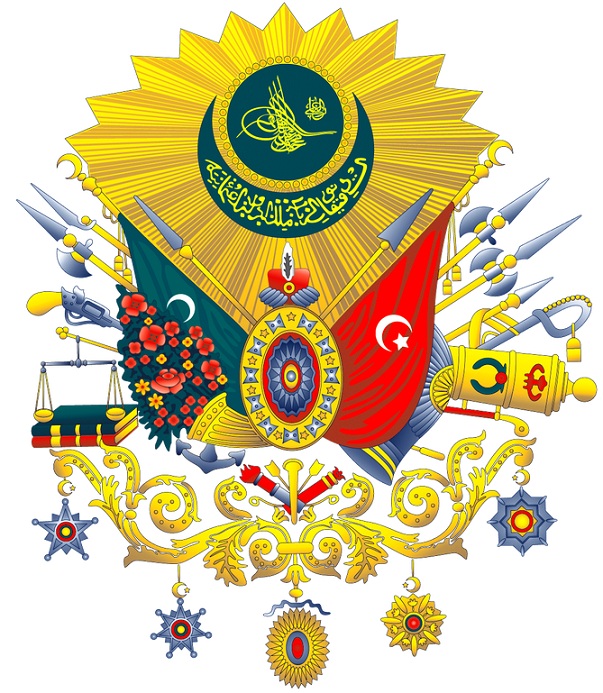
The Royal Seal of the House of Osman, c. 1882.
It's festooned with more weapons, bladed and gunpowder, than a pick-up truck in Texas.
Others tried to claim the caliphate, or considered doing do: notably
King Husayn of the Hijaz in Arabia, who was ultimately defeated by the Sa`udis; and King Fu’ad of Egypt. Islamic
conferences on the caliphate met in Mecca in 1926 and Jerusalem in 1931, but could not agree on the structure and function
of the office, much less on someone to occupy it. About
the same time Rashid Rida, a leading Syrian-Egyptian Islamic “modernist,” advocated a caliph as a preeminent mujtahid,
or exerciser of ijtihad (“updater” of Islamic law), while both of the Muslim Brotherhood’s major
thinkers--Hasan al-Banna, its founder, and later Sayyid Qutb, its foremost theorist—endorsed the caliphate.
Outside the Arab world, the Indo-Pakistani thinker Abu A`la Mawdudi directly pushed for the caliphate’s re-establishment,
stretching from Morocco to Indonesia.
However, the efforts of the Muslim Brotherhood and Mawdudi notwithstanding, from the 1950s until recently,
the Pan-Islamic idea of the caliphate largely took a back seat to either enthnolinguistic-based unity schemes (Pan-Arabism,
Pan-Turkism) or to nation-state sovereignty. But in recent decades (certainly since 1979), the failure
of such agendas has caused many of the world’s 1.6 billion Muslims to take another look at Islamic history as a unifying
force for the ummah—which, in Sunni contexts, means chiefly the caliphate. Pro-caliphal
propaganda has been sowed around the world, first and foremost, since 1952 by Hizb al-Tahrir, which openly promoted
the resurrection of the caliphate. (I have attended two of this organization’s yearly meetings in
the US, in 2009 and 2012, and written on the former in the “Washington Times” and on the latter at my website.) Zeal for the caliphate particularly consumes many in Pakistan, where
over a dozen parties espouse it (as per Vernie Liebl, “The Caliphate,” Middle Eastern Studies, Vol. 45,
No. 3, May 2009, pp. 373-391). So ISIS’s new caliphate did not spring ex nihilo from al-Baghdadi’s
fevered brow; rather, the groundwork for bringing back such has been being laid almost since the last Ottoman ruler was deposed.
Many Muslims—probably a minority, but still tens if not hundreds of millions—are willing to consider a
renewed caliphate as a unifier and a point of pride for their faith, the world’s second-largest. But
most of those probably would not have made the leader of ISIS their first choice.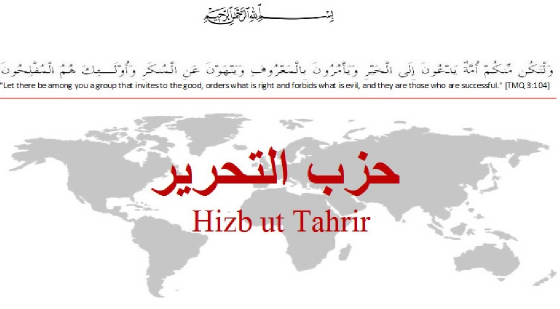
Home page of the "Party of Liberation's" website. HT has been the John the
Baptist to Caliph Ibrahim's messianic success.
How does “Caliph Ibrahim” stack up against historical Islamic standards? According
to Ibn Khaldun, the great medieval Muslim sociologist and historian, the caliph’s prerequisites are: 1) knowledge of
Islamic law; 2) honesty and virtue; 3) ability to lead and wage jihad (yes, holy war); 4) physical health
and lack of bodily defects; 5) Qurayshi origin (descent from Muhammad); and of course 7) maleness (see The Muqaddimah,
Princeton University, 1981, pp. 158-60). But as Bernard Lewis points out (The Political
Language of Islam, University of Chicago, 1988, p. 99 and passim), as Islamic history wore on “legitimacy…of
qualifications…was progressively reduced to the point where, in effect, only two conditions remained—power and
Islam. As long as the ruler possessed the necessary armed strength to seize and hold power, and as long as he was a Muslim,
however minimal and however nominal, that sufficed.” According to Liebl (pp. 387ff), that medieval/early
modern concept of the caliphate was echoed in, and given the stamp of approval by, the 1926 Cairo conference, which mandated
only that the caliph be a Muslim and a ”free sovereign capable of defending Islam”—of waging jihad, in other
words. (It was even stated that the caliph could accede to power via conquest.)
“Caliph Ibrahim” fits a number of Ibn Khaldun’s
requirements: PhD in Islamic law, demonstrated aptitude for jihad, health, and XY chromosomes. His followers
probably credit him with probity, as well. He lacks only Muhammadan descent (although don’t be surprised
if a fatwa to that effect from a caliphal-friendly `alim shows up in short order). And
he certainly meets the two bare bones requirements as laid out by the Cairo Conference. Just as Usama bin
Ladin, a renegade non-cleric, could issue a fatwa of “jihad against Jews and Crusaders” and have it heeded by many, Abu Bakr al-Baghdadi, a renegade leader, can proclaim a caliphate with himself in command.
In fact, the latter probably has more legitimacy than UBL, since he actually rules substantial territory, is far more
formally knowledgable about Islam, and has been in the front ranks fighting against the avowed enemies of Islam (rather than
having spent the most recent years plotting from a cave or safe house). Nothing succeeds like success, especially when it comes to the caliphate.
A decade ago the US National Intelligence Council tried to
peer into the palantir and envision geopolitics in 2020. Part of that included the fictional scenario of a new caliphate.
The two most important “lessons learned” from this exercise include the following: 1) “a Caliphate
would not have to be entirely successful…to present a serious challenge to the international order”;
and 2) “the proclamation of a caliphate would not lessen the likelihood of terrorism and, in fomenting more conflict,
could fuel a new generation of terrorists.” As the first of these contentions is already being borne
out—with the erasure of the Iraqi-Syrian border, Jordan’s possibly next—and the second almost sure to follow, concern over the new caliphate is more justified than dismissive sang-froid.  
Caliph Ibrahim & former Ottoman Caliph Mehmet V. Both proclaimed jihad; one is
just a snazzier dresser with more bling.
But while the self-styled caliphal “Islamic State” is quite problematic, it’s perhaps
not the geopolitical disaster that some would have it. First, al-Badri’s
caliphate may yet be rejected by the non-Arab-jihadist Muslim population, on the grounds of his lacking Qurayshi bona
fides and/or his deficiency of ties to the last Ottoman caliph. Second, more reputable
organizations like the Organization of Islamic Cooperation or al-Azhar University/Mosque—Sunni Islam’s highest
authority (founded, ironically, by the aforementioned Shi`i Fatimids)—will almost inevitably condemn and illegitimize
the “Islamic State” [IS]. Third, claimants with far more plausible claims to the caliphate--such
as descendants of the Ottoman royal line, King Abd Allah II of Jordan or, perhaps most credibly, the family of Barkat Ali Khan Mukarram Jah Asaf Jah VIII, with ties to the Ottoman and Mughal rulers (see Liebl, pp. 384ff.)—might dispute
the pretensions of “Caliph Ibrahim.” So too might the Saudis, who have never asserted
such but whose rulership of Mecca and Medina makes their claim more religiously, if less militantly, convincing.
Some argue that the new caliphate’s brutal
practices of beheading and crucifixion will inevitably make it unpopular and lead to its demise. Perhaps.
But there’s a problem with that thesis: both beheading and crucifixion are enjoined in the Qur’an for,
respectively, battlefield opponents and those who “war against Allah (and Muhammad)” and/or cause “immorality.”
(Here is my analysis of Islamic decapitation; an excellent break-down of the Qur’anic passage backstopping crucifixion can be found here.) IS[IS] may be violent, but it’s not thereby unIslamic;
in fact, the caliphate can claim, quite plausibly, to be hewing closer to the Qur’an than the Sunni leaders in Amman
or Riyadh—never mind the murtaddun, “apostates,” ruling in Damascus and Baghdad—as it hews
through infidel necks.
As
for the alleged threat IS[IS] poses to the West in general and the US in particular: in the near term,
such is doubtful—hyperbolic claims about conquering Rome notwithstanding—but on a long(er) time frame,
“Caliph Ibrahim,” if he and his devotees stay in power, is indeed a clear and present danger to our allies and
interests in the Middle East proper. Not just Jordan and northern Saudi Arabia are in the caliph’s crosshairs; much more ominously, IS[IS]
almost certainly plans on attacking Israel in order to “liberate” al-Quds, Jerusalem. This
is all the more true to the extent that the new caliphate is motivated by eschatological fervor (as per my previous post). Al-Badri’s hubris is so great that he may even begin
to think of himself in Mahdist terms—if his followers are not already doing so.
How on earth is any of this positive?
A number of ways come to mind. First, a caliph that enjoins beheadings and
crucifixions and simultaneously adduces his strict adherence to the Qur’an and the example of Muhammad might,
just might, cause some Muslims to start questioning slavish adherence to same. Second, this caliphate is
inexorably exposing the fact that Iraq and Syria (and likely Jordan) possess only the thinnest gauze of legitimacy, and that
the ethnic and sectarian realities on the ground would likely be better served by a reversion to the Ottoman realities; certainly
the Kurds would benefit thereby. Third, a caliph and state dedicated to jihad against not just non-Muslims,
but Shi`is, would (further) draw Jordan, Sa`udi Arabia and Egypt—and likely even Turkey—into closer cooperation
with the US and Israel. Relatedly, perhaps even the world’s foremost state sponsor of terror—the
Islamic Republic of Iran—might realize that the Dajjal in their midst is worse than the Great Satan over the horizon.
Fourth, with a Qur’anic literalist caliphate subjugating tens of thousands of Christians to dhimmi status,
and raping and killing those who object, perhaps at long last the majority-Christian countries of the world—led by the
largest one, the US—will stand up for their co-religionists in the Middle East.

The Sack of Rome by Muslim Arabs (846 AD) as depicted on a $6 US of Islam bill. Sheer
genius from moneyartstore.com
And who knows? If the US, or at least this
administration, is too craven to protect Christians from such a horrific caliphate, then an El Cid may emerge from a more worthy venue--one that is not ashamed to stand up for his, and its, civilizational, and yes, religious,
heritage.
[Addendum, as of 7.5.14: turns out that not just al-Baghdadi but his "vice-caliph," Abu Abd
Allah al-Husayni "al-Qurayshi," claims lineal decent from Muhammad, the founder of Islam. I had somehow missed that when I originally posted this.]
9:13 pm edt
|
|
|
|
| Jamkaran Mosque near Qom, Iran (during my trip there Aug. 2008) |
|
|
|
